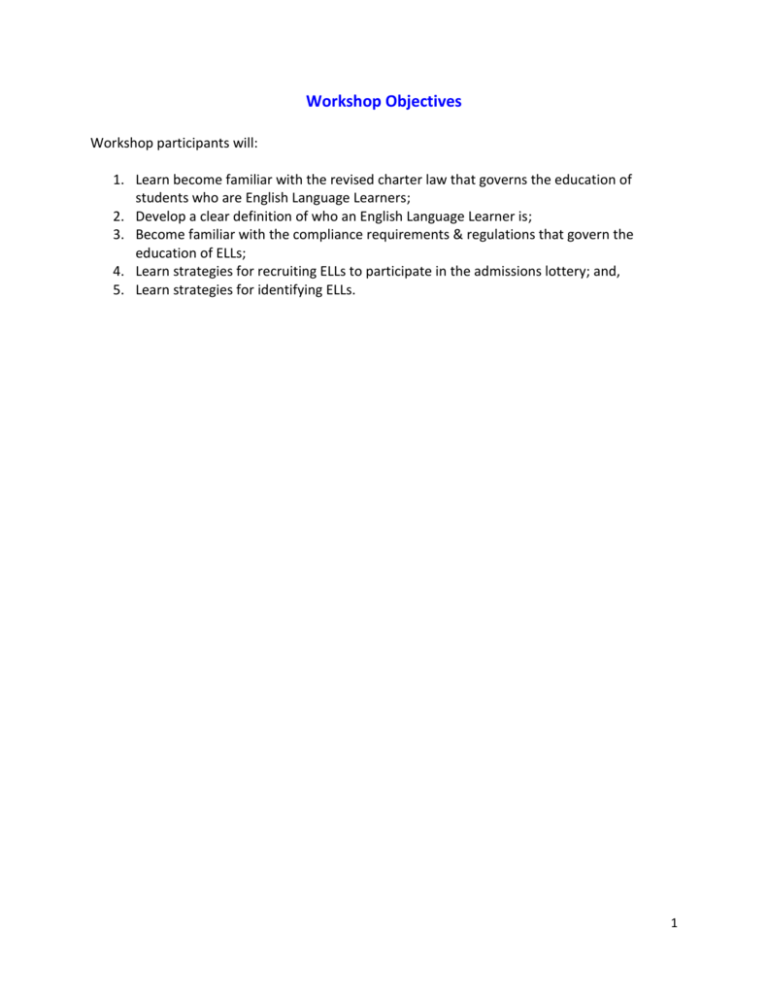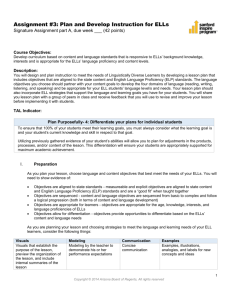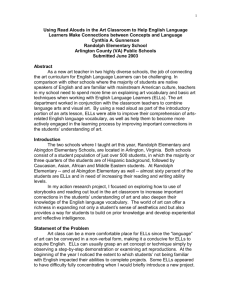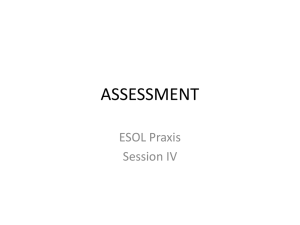Jan. 18 ELL Workshop Part I
advertisement

Workshop Objectives Workshop participants will: 1. Learn become familiar with the revised charter law that governs the education of students who are English Language Learners; 2. Develop a clear definition of who an English Language Learner is; 3. Become familiar with the compliance requirements & regulations that govern the education of ELLs; 4. Learn strategies for recruiting ELLs to participate in the admissions lottery; and, 5. Learn strategies for identifying ELLs. 1 Quiz on English Language Learners Directions: Read the following statements and determine if each is either TRUE or FALSE. 1. English Language Learners (ELLs) are only students from homes where a language other than English is spoken. _____________ 2. One in four students in New York City is an English Language Learner. _____________ 3. The revised Charter law does not require schools to meet enrollment and retention targets for students with special needs as well as those who are ELLs. _____________ 4. There are three (3) subpopulations of English Language Learners. _____________ 5. Charter schools do not have to adhere to Chancellor’s Regulations. _____________ 6. Charters must demonstrate that they have a well defined program to support academic success and English language proficiency among ELLs. _____________ 7. The Home Language Survey (HLIS) should only be administered to ELLs and immigrant families. _____________ 8. The New York State English as a Second Language Achievement Test (NYSESLAT) is administered only annually. _____________ 9. The HLIS should be administered to every incoming student and the administration should be done by anyone in the school. _____________ 10. Schools should only administer the Language Assessment Battery-Revised (LAB-R) to only students who they know are ELLs. _____________ 2 Quiz on English Language Learners (Answer Sheet) Directions: Read the following statements and determine if each is either TRUE or FALSE. 1. English Language Learners (ELLs) are only students from homes where a language other than English is spoken. FALSE. ELLs are students from homes where a language other than English is spoken and who score below a State designated level of proficiency on a test of English language skills. 2. Approximately 1 in 4 students in New York City is an English Language Learner. TRUE. Approximately 26% of students in an ELL. 3. The revised Charter law does not require schools to meet enrollment and retention targets for students with special needs as well as those who are ELLs. FALSE. Schools are required to meet enrollment targets for ELLs and SPED set forth by the state authorizers. 4. There are three (3) subpopulations of English Language Learners. FALSE. There are five subpopulations of ELLs: New Comers; Long term ELLs; ELLs with special needs; Students with Interrupted Formal Education (SIFE); and former ELLs. 5. Charter schools do not have to adhere to Chancellor’s Regulations. TRUE. Charters do not have to adhere to Chancellor’s Regulations (Part 154) when serving ELLs. 6. Charters must demonstrate that they have a well defined program to support the academic success and English language proficiency among ELLs. TRUE. 7. The Home Language Survey should only be administered to ELLs and immigrant families. FALSE. 8. The New York State English as a Second Language Achievement Test (NYSESLAT) is administered only annually. TRUE. 9. The HLIS should be administered to every incoming student and the administration should be done by anyone in the school. FALSE. It should be administered to every incoming student and done only by a pedagogue. 10. Schools should only administer the Language Assessment Battery-Revised (LAB-R) to only students who they know are ELLs. FALSE. The tests should be administer to students when the staff is not sure if the child is an ELL. It’s a test of verification. 3 “Laws of New York/Education/Article 56 (Charter Schools)” § 2854. General requirements. 2.Admissions; enrollment; students. (a) A charter school shall be nonsectarian in its programs, admission policies, employment practices, and all other operations and shall not charge tuition or fees; provided that a charter school may require the payment of fees on the same basis and to the same extent as other public schools. A charter school shall not discriminate against any student, employee or any other person on the basis of ethnicity, national origin, gender, or disability or any other ground that would be unlawful if done by a school. Admission of students shall not be limited on the basis of intellectual ability, measures of achievement or aptitude, athletic ability, disability, race, creed, gender, national origin, religion, or ancestry; provided, however, that nothing in this article shall be construed to prevent the establishment of a single-sex charter school or a charter school designed to provide expanded learning opportunities for students at-risk of academic failure or students with disabilities and English language learners; and provided, further, that the charter school shall demonstrate good faith efforts to attract and retain a comparable or greater enrollment of students with disabilities, English language learners, and students who are eligible applicants for the free and reduced price lunch program when compared to the enrollment figures for such students in the school district in which the charter school is located. http://www.p12.nysed.gov/psc/law.html How do I meet my enrollment target for ELLs? NYSED Demographic comparison Table: http://www.p12.nysed.gov/psc/startcharter.html 4 ELL Subpopulations Newcomers: Students who are new to the United States. These students are clustered in early elementary and early high school grades. (Note that 43% of all ELLs are foreign born) Long-term ELLs: Students who have completed at least six years of ELL services in NYC schools and continue to require them. (Almost 13% 2009 data) ELLs with Special Needs: ELLs served by and Individualized Education Plan (IEP). An IEP team determines eligibility for special education services and, if eligible, the language in which the special education is delivered. (Almost 22%) Students with Interrupted Formal Education: ELLs who have entered a US school after second grade; have had at least two years less schooling than their peers; function at least two grade years below expected grade level in reading and math; and may be pre-literate in their first language. (Almost 11% have been SIFE at some point in their lives) Former ELLs: Students who have reached proficiency on a test of English language skills and no longer require ELL services. Top Languages Five (5) Spoken by ELLs 1. 2. 3. 4. 5. Spanish (68% of ELLs) Chinese (11%) Bengali (btwn 2.3-2.9%) Arabic (btwn 2.3-2.9%) Haitian Creole (between 2.3-2.9%) 5 Strategies for Recruiting ELLs 1. Ethnic Media a. New York Community Media Alliance http://www.indypressny.org/nycma/voices/457/ i. 350 weeklies; ii. 26 foreign-language dailies; iii. A readership of well over 3.5 million of which 1.8 million have little or no English-language skills, according to the Mayor's Office on Immigrant Affairs. 2. Mayor’s Office on Immigrant Affairs http://www.nyc.gov/html/imm/html/home/home.shtml 3. NY Immigration Coalition http://www.thenyic.org/ 4. Religious organizations 5. Community Based Organizations that serve immigrant populations (CBO’s) 6. Local politicians—leave brochures & flyers in their offices as well as ask them which CBO’s should you particularly target 6







